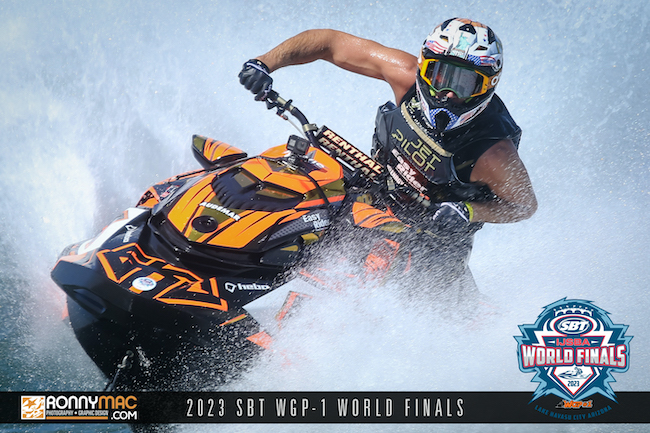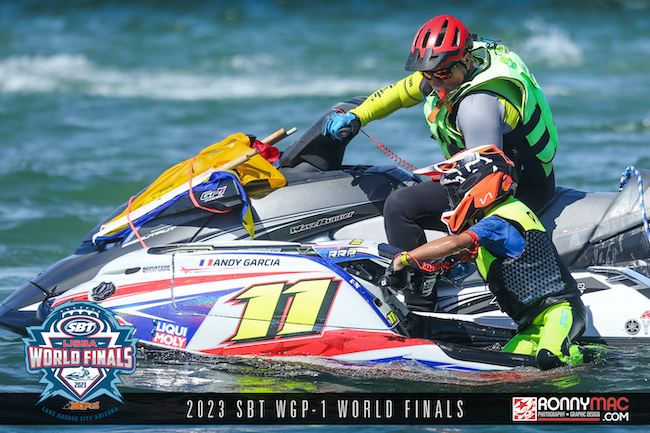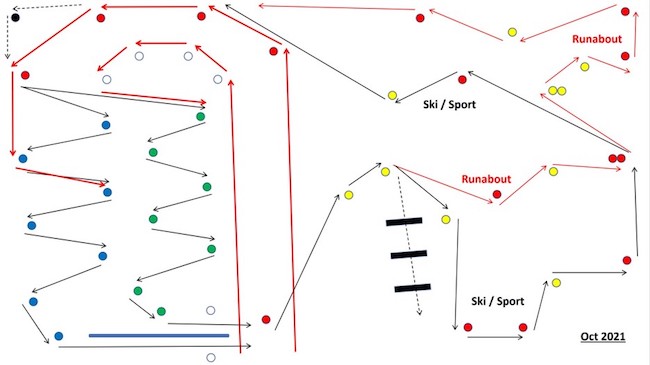
Following an extended period of accepting rule change suggestions from racers, IJSBA has compiled and released a set of rule suggestions for the 2025 Competition Rule Book. This year, for the first time, the newly-created Rules Committee will play a part in the process, with the committee’s response to the suggested rule changes to be posted, and taken into consideration in the compilation of the final draft of the 2025 Rule Book.
According to the procedure set out by IJSBA, “The IJSBA Managing Director will prepare a set of recommendations for these suggestions. This year, an ad hoc Rules Committee was created and IJSBA will post a response from this committee as well. If you have questions or comments regarding this posting or believe you have submitted a suggestion not included, please email: [email protected].”

The full list of suggested rule changes under consideration, as submitted by racers, is as follows, with IJSBA notations in bold:
- Modify rule excluding promoter participation to allow for this with certain oversite features.
- Refine Ski GP Rules to remove some references to the donor watercraft (pump length, etc.).
The way the f style rules are working as you know is that after the coral if no complain all is good .
Note: The Freestyle Corral does not prevent protests for mechanical violations or missing parts, participation in the corral only prevents protests of hull design and specifications.
On a stand up the intake grate is put there for safety and also in some case to use a loader to load the pump .
What is happening now is the many people are using only a loader plate fix on the side or not even anything as grate
To me this is a safety issue just like the lanyard
I would do away with the restricted plate in this class since none of the ones that were used at world finals this year are the same size. the speed is about 6mph faster than the 4stroke yamaha seems to be safe . I would think another item for safety in this class would be a letter of proficient from there promoter saying that the Jr is able to control the ski at the increased speeds.
It is known that swapping out the factory camshafts from the normally aspirated VXR ski into the supercharged SVHO makes more horsepower. Some have argued that they are “OEM” and are allowed per the rules for the “Stock Runabout” class. The way I am understanding the rules, is that you could swap cams from any “SVHO” model, in this case 2014-2025 from any Yamaha ski with any model originally equipped SVHO engine. Or for SeaDoo, any 2016-2023 300 ski could use cams from any of those years. I’m not sure how the rules could be written for the use of the 230 cams for the same years, if that’s an advantage or not. I also suppose one could also make the case, per the rules, that an RXP-X couldn’t use the same cams as an RXT-X or a GP1800R SVHO couldn’t use cams from a FX SVHO, or vice versa.
From speaking to multiple tuners (Yamaha), it’s not a direct plug-n-play swap. The addition (temporary or not) of o2 sensors, air flow meters, and tuning are necessary to get the tune “correct.” This small gain, yet still an advantage, adds a lot of cost to a “Stock” class that most racers would have to hire out to get done, making it harder to gain new racers, like myself, getting into the sport, or even retaining current racers. Adding in clarification, whether allowed or not, would help with costs and complexities associated with building a ski for the “Stock Runabout” class.
RAS.1.2 Original equipment parts may be updated or backdated to original equipment parts of the same model. The part must be a bolt-on requiring no modifications to that part or any other parts except where rules allow substitutions or modifications. Models with the same designation (i.e. RXP-X, SHVO, etc.) will generally be considered the same model unless restricted in the homologation listing (See Appendix).
RAS.3.4 Camshaft(s) must remain stock. Replacement bearings or bearing shells are allowed, providing they maintain their original type and dimensions. Camshaft timing may be changed.
- 2. Can the rules clarify whether additional tubing and ventilation is allowed or not, in addition to the OEM ventilation tubes?
RAS.2.13 Engine compartment ventilation tubes must remain as originally equipped.
- 3. Can the rules clarify whether aftermarket “keepers” can be used or not? Although the GP1800R SVHO keepers are very good on their own, I would like the option to use some aftermarket ones when I get my valve springs and retainers installed next month, and don’t won’t to have to pay for this service again if I move up classes and my tuner recommends different keepers. For the “Stock” class, I think there is zero advantage. It’s just more of a piece of mind item using “better” keepers.
RAS.3.5 Aftermarket valve springs and valve spring retainers may be used.
- 4. Restricting impellers to just a single impeller like OEM, not a twin impeller, which is currently allowed. It’s a major advantage having the twin impeller, but gets away from the roots as a “stock” ski and doubles the cost. Since the West Coast series runs in elevation and sea level, two impellers, if not more, are necessary. I think it would be a win-win to restrict it to just a single impeller.
RAS.10.1 Impeller may be modified or aftermarket, providing that the original diameter is maintained. Replacement wear rings that are within OEM internal diameter specifications may be used. Silicone adhesive sealant may be used in addition to original equipment seal to seal pump inlet. Visibility spout must be removed or plugged
Runabout Naturally Aspirated: add runabout naturally aspirated to the displacement guide specifically stating what the requirements are for this class. In the past, the class has been four stroke stock 1800 cc (now1900) or two stroke limited 1300 cc (aftermarket hoods are not allowed)
Runabout naturally aspirated is not in the 2024 rulebook and I was unable to find it in a few previous years. I was able to find the displacement in a previous IJSBA post (see below).
Note: This class was, many years ago, a formula class combining Two Stroke Limited and Four Stroke Stock rules. This definition was for a specific World Finals. Afterwards, Mark Hahn 300 Competitors petitioned this class to be a Naturally Aspirated Class which used actual Open Rules. If this suggestion is adopted it will appear in the Rule Book as a specific category likely called “Formula Naturally Aspirated.”
Ski GP,,,, boost control, remove any limits and allow electronic control. (it’s nearly impossible to make a good test of this unless you get into the ECU of the pilot) the real number of boot on the water is much different then the trailer test.
Runabout 1100 open ,,, change to “GP” this will open the class up to other manufacturers, Sea Doo needs the GSX hull the spark is too small to compete with the Yamaha
Expert Ski GP ,,,, change this class to Expert Ski Modified
Ski Modified,,,,, clarify rules 1. cam gears 2. fuel pump with regulator , fuel tank (some hulls run other tanks then what came with the engine package originally ), exhaust collector to be modified or aftermarket. ( some hulls do not fit the original)
Ski 1100 Modified Yamaha 1050 can use any exhaust manifold that is OEM by Yamaha. (Yamaha has 3 different manifolds and depending on your hull one fits for some and not others.
Ski Modified , open up the pump rule for any aftermarket pump as long as it remains OEM dia. ( many company have pumps to sale and they contribute to the sport)
Suggestion: I suggest the following rule change: Changing VSK 2.2 to allow anyone to create and use modified top decks. Currently, there is a monopoly on who can sell “legal” top decks. This is due to wording relating to the historical approval of the ski. Opening up the rules for everyone to have a chance continues the growth and development of the class, as well as allows the riders to have another aspect of the hobby to get involved in.
Suggestion: I suggest the following rule change: Changing VSK 2.2 to allow modifications to the bottom of the ski, as long as it stays within the original length (front to back) and width (left to right).
Suggestion : I suggest the following rule change: Changing the wording of VSK 2.4. The current wording allows that we can use a maximum of 2 sponsons. The problem is the definition of the word ‘sponson’ is interpreted differently by the different tech personnel. I suggest the wording be changed to “All watercraft may be equipped with a maximum of 1 set of tubbies (front sponsons) and 1 set of sponsons (rear sponsons). A set is defined as a two part system with a left and right component.” I feel that this would relieve some of the confusion that takes place regarding the rule. People tend to call the tubbies, front sponsons and subject them to the dimension requirements and maximum requirements.
Suggestion : I suggest the following rule change: Wording changes relating to VSK 4.3 and VSK 5.2. VSK 4.3 is a rule regarding fuel injection and VSK 5.2 is a rule regarding CDI ignition. The nature of adding an electronic fuel injection system requires the addition of additional sensors, like TPS, MAP, MAF, ect. Rule VSK 5.2 says that no additional sensors may be added. This creates a contradiction, which I feel will lead to friction going through tech. I suggest adding a line to the wording on VSK 4.3 to “Addition of sensors required for electronic fuel injection is allowed”.
Suggestion : I suggest the following rule change: Allowing titanium in rule VSK 6.1. Titanium was used on the top race skis from the early 1980’s to the last year of 440 superstock and 550 modified. I understand the motivation of this rule is to keep costs down, but the additional costs of using titanium drive shafts over stainless is significantly less than the cost of other modifications that are done to the motors and pumps that are somewhat necessary to have a competitive ski.
Suggestion : I suggest the following rule change: Clarifying how VSK 6.1 is measured. The rule is about ‘the overall length of a complete pump and nozzle assembly. The 750 pumps don’t have a shoe as part of the assembly while the 550 does. The rule is there is an allowance of additional length compared to the stock length of the “complete pump assembly”. If you can see the attached picture.
Note: This suggestion was essentially made by two different parties but only posted once.
I would like to propose a rule change for the 1997 Seadoo xp be allowed to use a carbon fiber hood in limited class, the 1997xp is 95 pounds heavier than its 1996 xp counterpart, the 96xp is allowed a carbon hood in limited class
Note: This suggestion was made by three different parties. IJSBA received a similar amount of correspondence apparently aware that this suggestion was being made and asking to preserve the status quo.
On ski gp and sport gp class for engine below 1100 cc. engine can do forced induction but there’s limit of boost. I suggest that no electronic boost control allow need to be only mechanical boost control or manual adjustable only, so they can’t use aftermarket ecu to control awhile racing in the moto.
NOTE: This suggestion was clarified with the submitting party who intends this this suggestion to be a preservation of the existing allowance of mechanical regulation of boost pressure.
Clarify what brand and model to use for checking boost pressure so everyone will have the same reading on Ski gp and sport gp class for boosted engine.
NOTE: This suggestion was clarified with the submitting party who intends IJSBA Rules to update the boost pressure blow off or checking device to mandate the product(s) by name.
Runabout superstock class, please clarify if the engine allow to use aftermarket rods and pistons. Because on rule books saying aftermarket crankshaft is allow within 5% of weight.
NOTE: Persons advocating for shorter more concise rules should take heed of what this suggestion is adressing. The Superstock Class has always allowed aftermarket connecting rods as part of the crankshaft provision (pins, bolts, bearings, too). This will be rephrased to describe all components of a crankshaft assembly in the 2025 Publishing.
 Do NOT Impede Progress of another Racer – Safety Rule
Do NOT Impede Progress of another Racer – Safety Rule
In the drawing here the merge lane corridor is separated by the (Sausage Buoy) and this would be proper set up, but the sausage buoy does not extend this long and is set back further behind the finish line. We are adding a longer sausage buoy (an extra) to extend this corridor this year. The arrows indicate what I enforce and are in a straight line as racers should follow a racing line that is as straight as possible and cannot move into the opposing lane. After the sausage Buoy racing is a straight line to the merge bupy. A Racer may not move into the other lane, inside or outside, push, block, Slow or Impede the progress of another racer, in order to gain an advantage in the safety corridor leading into the merge buoy. These lanes in this safety corridor may not be crossed. Race in straight line towards merge buoy. The racer with the lead going into merge buoy has the advantage. Passing is allowed in a straight line. This rule is in place to minimize merge collisions in a higher probability impact zone. Safety corridor penalties cannot be made up during race. You cannot hit my sausage buoys ( 1 lap penalty) You cannot cross over , swing wide or merge into the other lane, coming off of your final turn on inside split or outside split. (1 lap penalty) Racer will maintain straight line and hold that line through corridor. Impede progress of another racer in these lanes is (1 lap Penalty.)






